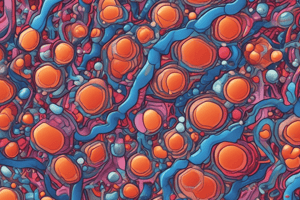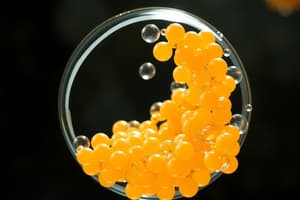Podcast
Questions and Answers
Which type of lipid acts as energy reserves primarily stored in adipose tissue?
Which type of lipid acts as energy reserves primarily stored in adipose tissue?
- Cholesterol
- Sterols
- Triglycerides (correct)
- Phospholipids
Which lipids are involved in the emulsification and absorption of fats and fat-soluble nutrients?
Which lipids are involved in the emulsification and absorption of fats and fat-soluble nutrients?
- Bile acids
- Triglycerides
- Phospholipids (correct)
- Mineralcorticoids
Which type of lipid is pivotal in the structural integrity of the cell membrane?
Which type of lipid is pivotal in the structural integrity of the cell membrane?
- Bile acids
- Triglycerides
- Phospholipids (correct)
- Cholesterol
Cholesterol is metabolized into several important substances. Which of these is NOT one of those substances?
Cholesterol is metabolized into several important substances. Which of these is NOT one of those substances?
What is the function of subcutaneous adipose tissue in the body?
What is the function of subcutaneous adipose tissue in the body?
Which lipid-derived substances are crucial for digestive health?
Which lipid-derived substances are crucial for digestive health?
Which of the following is classified as a simple lipid?
Which of the following is classified as a simple lipid?
Which lipid type contains additional groups beyond alcohol and fatty acid?
Which lipid type contains additional groups beyond alcohol and fatty acid?
Which lipid class does phosphatidylcholine (PC) belong to?
Which lipid class does phosphatidylcholine (PC) belong to?
Which of the following is NOT a derived lipid?
Which of the following is NOT a derived lipid?
Which classification do wax esters fall under?
Which classification do wax esters fall under?
Which of the following is a subtype of glycolipids?
Which of the following is a subtype of glycolipids?
What are neutral lipids known for?
What are neutral lipids known for?
Which of these is considered a complex lipid?
Which of these is considered a complex lipid?
Flashcards are hidden until you start studying
Study Notes
Energy Storage and Insulation
- Triglycerides act as energy reserves, stored primarily in adipose tissue, specifically in adipocytes (fat cells)
- Triglycerides are broken down in the mitochondria to produce energy
- Subcutaneous adipose tissue helps maintain body temperature through insulation
Emulsification and Hormone Regulation
- Phospholipids emulsify fats, increasing absorption of fats and fat-soluble nutrients, such as sterols and vitamins
- Phospholipids can be converted into hormones, controlling smooth muscle contraction, blood clotting, and immune cell stimulation
Structural and Metabolic Functions
- Phospholipids are a structural element of cell membranes
- Cholesterol is metabolized into various hormones, including:
- Sex Hormones for reproduction
- Corticosteroids for stress response
- Mineralcorticoids for blood pressure regulation
Digestive Health and Immune Modulation
- Bile acids are essential for digestive health
- Vitamin D, an immune modulator, and other fat-soluble vitamins are contained in the fat of natural essential fatty acids
Lipids Classification
- Lipids can be classified into four categories: simple lipids, complex lipids, other complex lipids, and precursor and derived lipids.
Simple Lipids
- Esters of fatty acids with various alcohols.
- Examples: fats and waxes.
Complex Lipids
- Esters of fatty acids containing groups in addition to an alcohol and a fatty acid.
- Examples: phospholipids, glycolipids (glycosphingolipids).
Other Complex Lipids
- Examples: sulfolipids, amino lipids, and lipoproteins.
Precursor and Derived Lipids
- Include fatty acids, glycerol, steroids, other alcohols, fatty aldehydes, ketone bodies, hydrocarbons, lipid-soluble vitamins, and hormones.
- Neutral lipids: uncharged lipids, including acylglycerols (glycerides), cholesterol, and cholesteryl esters.
Classification Scheme
- Simple lipids include wax esters and triacylglycerol.
- Complex lipids include phospholipids (e.g., glycerophospholipids) and glycolipids (e.g., cerebrosides, gangliosides).
- Derived lipids include fatty acids, sterols, diglycerides, monoglycerides, and others.
- Glycerophospholipids include phosphatidylcholine (PC) and phosphatidylethanolamine (PE).
Studying That Suits You
Use AI to generate personalized quizzes and flashcards to suit your learning preferences.




